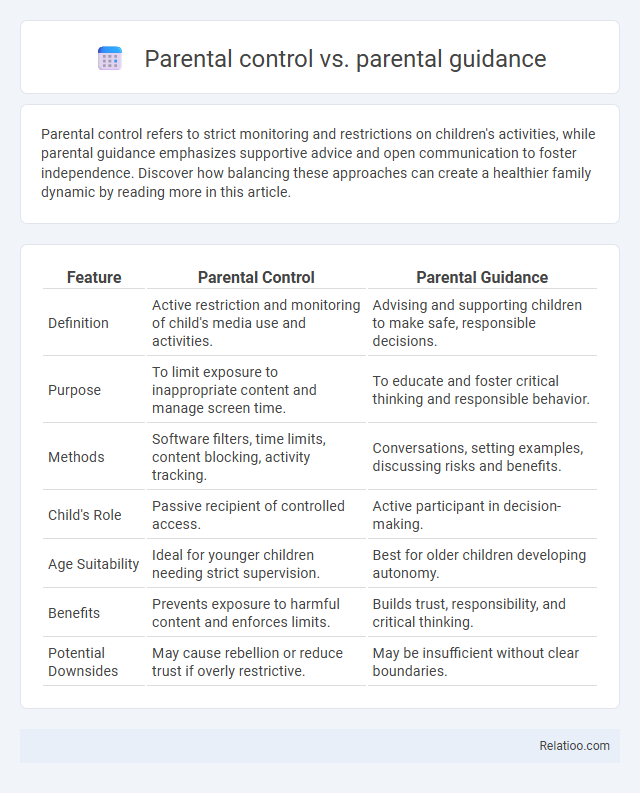Parental control refers to strict monitoring and restrictions on children's activities, while parental guidance emphasizes supportive advice and open communication to foster independence. Discover how balancing these approaches can create a healthier family dynamic by reading more in this article.
Table of Comparison
| Feature | Parental Control | Parental Guidance |
|---|---|---|
| Definition | Active restriction and monitoring of child's media use and activities. | Advising and supporting children to make safe, responsible decisions. |
| Purpose | To limit exposure to inappropriate content and manage screen time. | To educate and foster critical thinking and responsible behavior. |
| Methods | Software filters, time limits, content blocking, activity tracking. | Conversations, setting examples, discussing risks and benefits. |
| Child's Role | Passive recipient of controlled access. | Active participant in decision-making. |
| Age Suitability | Ideal for younger children needing strict supervision. | Best for older children developing autonomy. |
| Benefits | Prevents exposure to harmful content and enforces limits. | Builds trust, responsibility, and critical thinking. |
| Potential Downsides | May cause rebellion or reduce trust if overly restrictive. | May be insufficient without clear boundaries. |
Understanding Parental Control and Parental Guidance
Parental control involves setting strict rules and monitoring children's activities to ensure safety and appropriate behavior, often leveraging technology or specific restrictions. Parental guidance focuses on offering advice, support, and open communication to help children make informed decisions and develop critical thinking skills. Your understanding of these approaches helps balance protection with fostering independence for healthier child development.
Key Differences Between Parental Control and Guidance
Parental control involves strict regulation and restriction of a child's activities, aiming to limit exposure to potentially harmful content or behaviors, whereas parental guidance emphasizes providing advice, support, and open communication to help children make informed decisions. Parental control often relies on rules and monitoring tools, such as screen time limits and content filters, while parental guidance fosters trust and encourages autonomy and critical thinking. Parental authority encompasses the broader legal and moral rights of parents to make decisions on behalf of their children, combining elements of both control and guidance for effective child-rearing.
The Goals of Parental Control
Parental control aims to protect children from harmful content and regulate their behavior to ensure safety and proper development. It often involves setting strict rules, monitoring activities, and restricting access to certain media or environments to prevent exposure to risks. Unlike parental guidance, which encourages informed decision-making, parental control prioritizes direct intervention to achieve specific protective goals.
The Purpose of Parental Guidance
Parental guidance primarily aims to support you in fostering your child's development by offering advice, setting appropriate boundaries, and encouraging responsible decision-making. Unlike parental control, which enforces strict rules, parental guidance emphasizes communication and understanding to nurture independent thinking. Parental authority, while essential for establishing discipline, complements guidance by enforcing rules that protect your child's well-being in various environments.
Benefits of Parental Control in Child Development
Parental control provides structured boundaries that promote safety and discipline, essential for healthy child development. It helps children understand limits and consequences, fostering responsibility and self-regulation skills. By establishing clear rules, parental control supports cognitive and emotional growth, reducing exposure to harmful influences and enhancing overall well-being.
Advantages of Parental Guidance for Growing Children
Parental guidance supports children's emotional and cognitive development by providing age-appropriate advice and fostering open communication, which enhances decision-making skills and self-confidence. Unlike strict parental control, guidance encourages autonomy while still offering necessary boundaries, promoting a balanced approach to discipline. Emphasizing guidance helps children develop critical thinking and responsibility, essential for navigating complex social environments effectively.
Potential Drawbacks of Excessive Parental Control
Excessive parental control can lead to diminished child autonomy, stifling their ability to develop critical decision-making skills and self-confidence. Unlike parental guidance, which offers supportive advice, or parental authority, which establishes boundaries, overly strict control may foster resentment and hinder emotional growth. Your challenge is to balance oversight with freedom to promote healthy independence and resilience in your child's development.
How Parental Guidance Encourages Independence
Parental guidance encourages independence by providing supportive advice and setting appropriate boundaries that help children develop decision-making skills. Unlike parental control, which imposes strict rules, guidance allows for learning through experience while maintaining safety. Your role as a parent shifts to mentor, fostering resilience and confidence in your child's growth.
Finding the Right Balance: Control vs Guidance
Finding the right balance between parental control, guidance, and authority is essential for fostering a healthy relationship with Your child. Parental control involves setting firm rules and restrictions to ensure safety, while parental guidance emphasizes supportive advice and nurturing independence. Exercising parental authority effectively requires blending both approaches to empower Your child with freedom within clear boundaries, promoting trust and responsible decision-making.
Practical Tips for Parents: When to Control, When to Guide
Parental control involves setting clear rules and monitoring children's activities to ensure safety, especially for younger kids or in risky situations like online interactions. Parental guidance emphasizes supporting decision-making and offering advice to help children develop independence and critical thinking during adolescence. Practical application requires parents to increase control when immediate safety is at risk, while shifting towards guidance to nurture autonomy as children mature and demonstrate responsibility.

Infographic: Parental control vs Parental guidance
 relatioo.com
relatioo.com